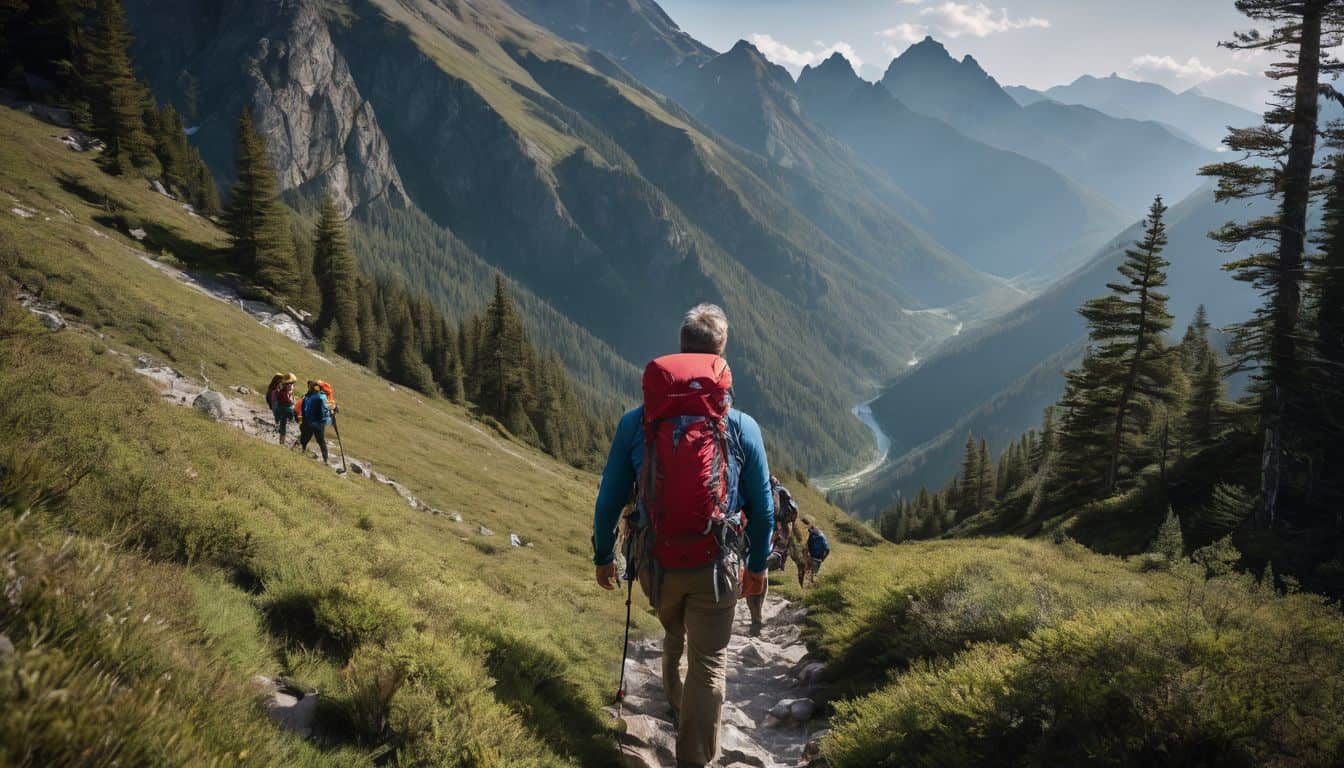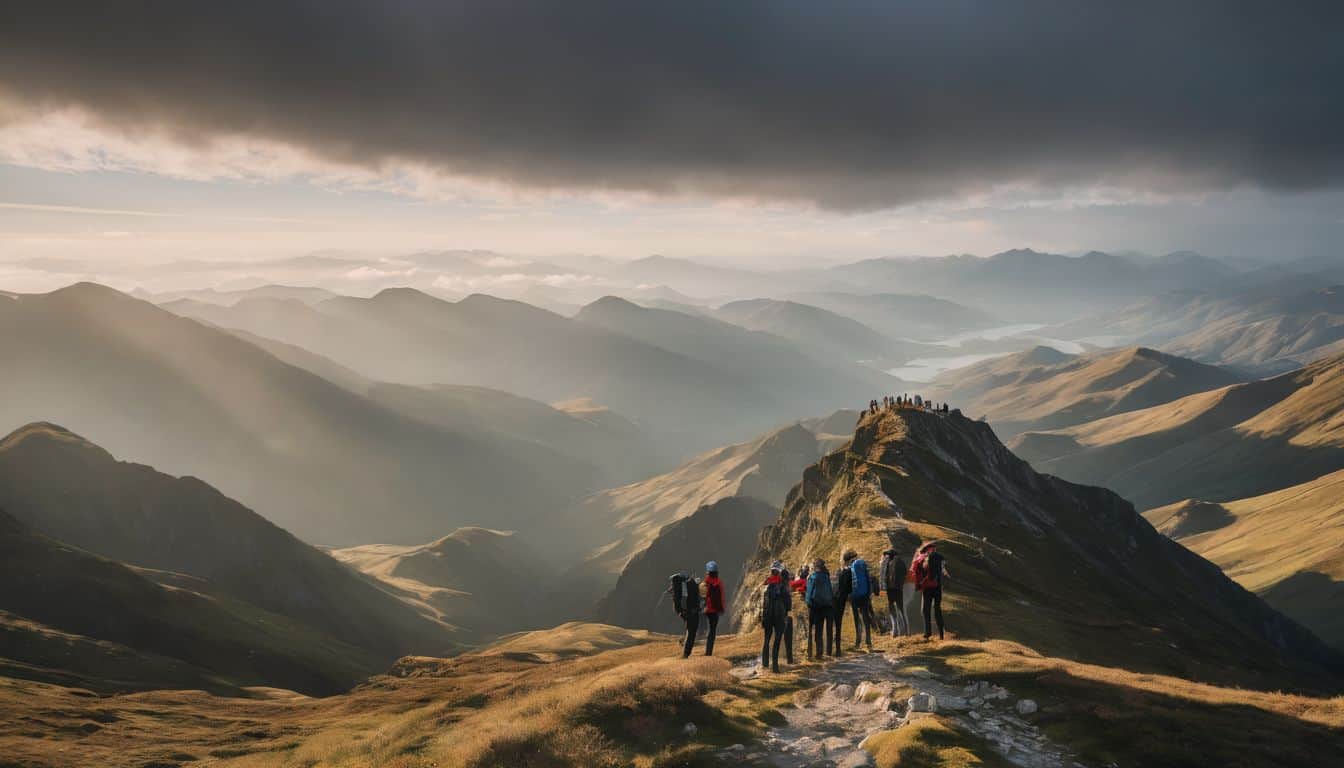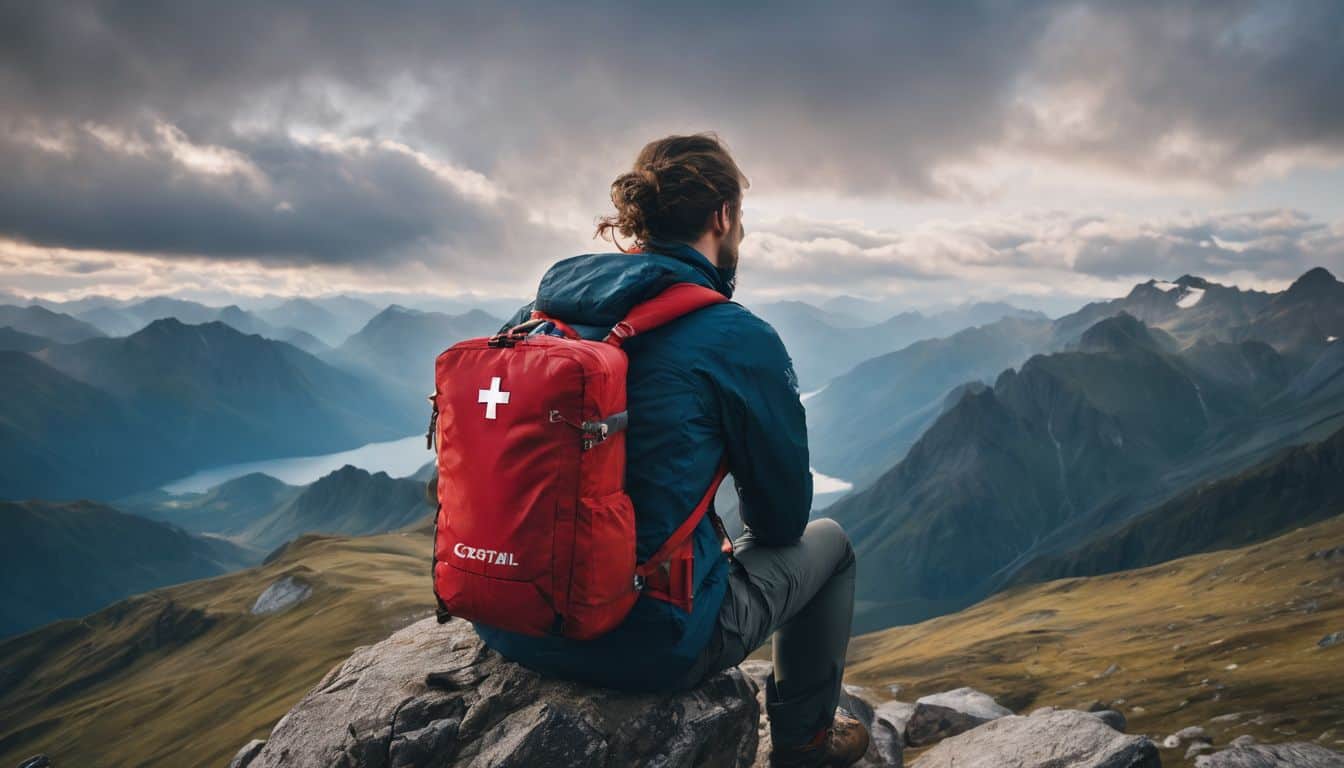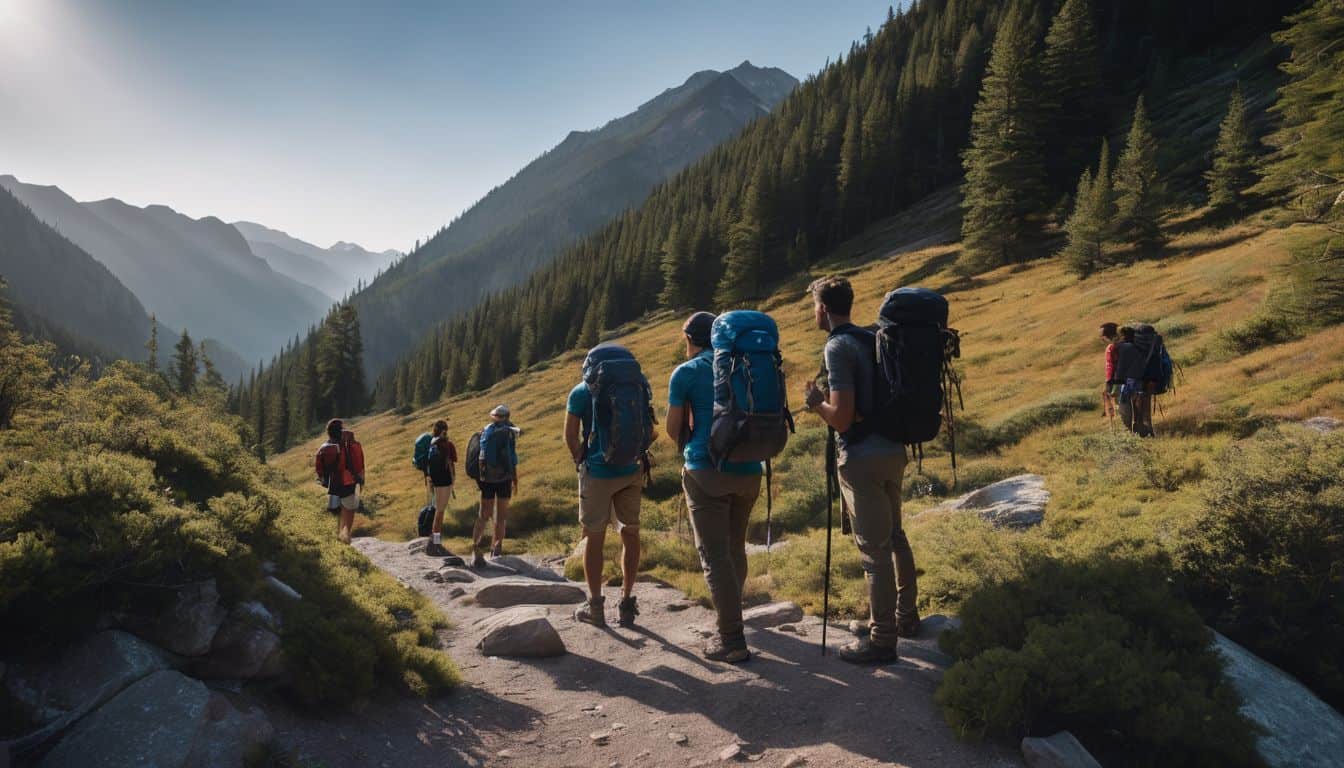Hiking is truly one of life’s most rewarding activities, but I completely understand the head-scratching confusion that can come with trying to decide between a guided tour and an independent hike.
Trust me, I’ve been down this road myself. After diving into a heap of research, it became clear that both options bring their own unique perks whether it’s insightful cultural experiences, substantial health benefits or just pure personal enjoyment.
In this article, we’ll unpack the pros and cons of each type of outing for you – giving you all the details you need to find your perfect match in hiking adventure. Ready? Let our journey into the wonderful realm of hiking begin!
Key Takeaways
- Guided hiking tours involve a skilled guide leading the group and taking care of logistics, making it worry-free and suitable for all hikers.
- Self – guided hiking tours offer freedom and flexibility to explore at your own pace, but require more responsibility for navigation and safety.
- Benefits of guided hikes include expert knowledge, personalized experiences, safety precautions, transportation assistance, group camaraderie, and learning opportunities.
- Benefits of self-guided hikes include independence, customizable experiences, helpful resources, expertise support if needed, and cost-effectiveness.
Guided vs Independent Hiking: Understanding the Difference
Guided hiking tours are organized trips led by experienced guides who provide expertise, knowledge, and support throughout the hike. On the other hand, self-guided hiking tours involve planning and navigating the trail independently without a professional guide.
Definition of guided hiking tours
A guided hiking tour means you hike with a skilled mountain guide. The guide knows the trail well and leads your group. Your group might be friends or people put together by a company that does hikes.
On this kind of trip, you have less to worry about. You do not need to find the way or deal with travel stuff because the guide takes care of it all. This type of tour suits anyone who enjoys hiking, no matter how much they know about it already.
The guides share their knowledge and keep everyone safe while out on the trails. But, these tours cost more than ones where you go alone without a guide, because you have to pay for extra things like having an expert there and sorting out details like getting there and back.
Definition of self-guided hiking tours
Self-guided hiking tours are trips you take on your own. You don’t need a tour guide for them. You explore walking routes or city areas by yourself. A company gives you a route, some info, and maybe even some extras to help your trip go smoothly.
But the rest is up to you!
That means it’s a lot about doing stuff by yourself. The good thing is that self-guided tours let you move at your own speed. You can decide where to go and when to stop. Does this save money? Sometimes yes! They tend to be cheaper than guided tours because there’s no guide fee to pay.
But remember: with freedom comes responsibility! Self-guided hikes may not be as safe as ones with guides, since there’s no one there watching out for hazards or problems along the way.
In-depth Look into Benefits of Guided vs Independent Hikes
Guided hikes let you get into nature without any stress. A guide takes care of finding the way and even setting up transport. This kind of hike can be great for all kinds of hikers, even if you are good at hiking already.
Hiking by yourself is different though. You get to control your own path and pace. If health is your main goal, this might be the best choice. You get to plan out how hard you want to work on a hike like this.
Pros and Cons of Guided Hiking Tours
Guided hiking tours offer the benefits of expert knowledge, personalized experiences, and increased safety precautions, while drawbacks include limited flexibility and higher costs.
Benefits of guided hiking tours
I love guided hiking tours because they offer a worry-free wilderness experience. The benefits of guided hiking tours include:
- Expertise and knowledge: Professional guides have extensive knowledge about the hiking area, including its history, flora, and fauna. They can provide interesting information and answer any questions you may have.
- Safety and security: With a guide, you can hike confidently knowing that someone experienced is leading the way. They are trained in first aid and can handle emergencies if they arise.
- Transportation and logistics: Guided tours take care of transportation to and from the trailhead, as well as any necessary permits or park fees. This eliminates the stress of planning these logistical details on your own.
- Group camaraderie: Guided hikes often involve a small group of like-minded individuals. This creates a sense of camaraderie as you share the experience with others who have similar interests.
- Personalized experience: Guides can tailor the hike to your preferences and abilities, ensuring that it matches your fitness level and desired pace.
- Learning opportunities: A guided tour provides an opportunity to learn new skills or improve existing ones, such as map reading or navigation techniques.
Drawbacks of guided hiking tours
Guided hiking tours have some drawbacks that you should consider:
- Limited freedom: In guided hiking tours, your itinerary and activities are predetermined, leaving you with less flexibility to explore on your own.
- Group dynamics: You may be grouped with strangers on guided hiking tours, which can affect the overall experience if you don’t get along well or have different preferences.
- Fixed itinerary: Since guided tours follow a fixed schedule, you may feel rushed or unable to spend more time in places that interest you.
- Dependence on the guide: You rely on the tour guide for navigation, information, and decision-making, which can limit your independence and personal exploration.
- Less spontaneity: Guided hikes often lack the element of surprise or spontaneity that comes with exploring independently.
Examples of Hiking Tours Suitable for Guides
Challenging and remote hikes like Mount Kilimanjaro or the Inca Trail are ideal for guided hiking tours, as they require expert knowledge and navigation skills. These hikes often involve difficult terrain, high altitudes, and potentially hazardous conditions, making it essential to have a knowledgeable guide to ensure the safety of hikers.
Additionally, hikes with specific cultural or historical significance such as the Camino de Santiago in Spain or the Appalachian Trail in the United States can greatly benefit from a guide who can provide valuable insights into the local culture and history along the way.
Challenging and remote hikes
For the more adventurous hikers out there, challenging and remote hikes can offer an incredible experience. These are hikes that take you off the beaten path and into secluded locations.
Think difficult and isolated treks in remote areas, where you’ll truly feel connected to nature. These types of hikes often require a skilled guide who knows the terrain and can ensure your safety.
They’re perfect for experienced hikers looking for a thrilling adventure in the wilderness. So if you’re up for a hiking expedition like no other, consider embarking on one of these guided tours designed especially for adventurous souls.
Hikes with specific cultural or historical significance
Hiking tours with cultural or historical significance are a great way to explore and learn about the heritage of a region. These hikes take you to places like ancient ruins, historic landmarks, and culturally significant sites.
With a guide by your side, you’ll get valuable insights and stories about the cultural or historical importance of the hike. It’s an opportunity to immerse yourself in the local culture, traditions, and gain a deeper understanding of the area’s heritage.
So lace up your hiking boots and embark on these explorations that offer more than just beautiful scenery!
Pros and Cons of Self-Guided Hiking Tours
Self-guided hiking tours offer the freedom to explore at your own pace and choose your own path, but they come with challenges such as lack of expertise and potential safety risks.
Benefits of self-guided hiking tours
Self-guided hiking tours have a lot of benefits. Here are some of them:
- Greater independence: With self-guided hikes, you have the freedom to go at your own pace and explore areas that interest you the most.
- Customizable experiences: You can personalize your hiking trip according to your preferences and interests. It can be a solo adventure or a fun group activity.
- Helpful resources: Many companies and tourist sites provide maps, directions, and suggestions for self-guided hikes, making it easier for you to plan your route.
- Expertise and support: Even though you’re on your own, you can still get advice and assistance from experts if needed. They can provide valuable information about the trail ahead or recommend nearby attractions.
- Cost-effective option: Self-guided tours often have lower upfront costs compared to guided tours, making them more budget-friendly. You also have the flexibility to choose accommodations, transportation, and meals that suit your budget.
Challenges of self-guided hiking tours
Planning your own route and navigating unfamiliar terrains can be challenging during a self-guided hiking tour. Carrying your own gear and supplies adds weight to your backpack, which can be physically demanding. Understanding local customs, dealing with language barriers, and finding accommodation or facilities along the way can also pose challenges without a guide. Additionally, self-guided hiking tours may lack the expertise and knowledge that a guide provides, making it harder to learn about the local culture, history, and wildlife.

Examples of Hikes Suitable for Self-Guided Hiking
Well-marked and popular trails, such as the Appalachian Trail or the Pacific Crest Trail, are excellent choices for self-guided hiking.
Well-marked and popular trails
When you’re going on a self-guided hike, it’s always helpful to choose well-marked and popular trails. These trails have clear paths that are easy to follow, so you won’t get lost along the way.
With prominent trail markers and signposts, you can navigate through the hike with confidence. Plus, popular hiking destinations often have established infrastructure like campsites and facilities, making your self-guided adventure more convenient.
So whether you’re a beginner or an experienced hiker, exploring these user-friendly routes will enhance your hiking experience. Enjoy the journey!
Hikes in familiar and accessible locations
I love going on hikes in familiar and accessible locations. They offer a great way to get some exercise, relax, and enjoy nature. These hikes are usually found on well-marked trails in local parks or scenic routes close to home.
They provide a wonderful opportunity to explore your surroundings while immersing yourself in the beauty of nature. Hiking in these places can also help improve your outdoor skills and prepare you for more challenging adventures in the future.
So lace up your shoes, grab a friend or two, and hit the walking trails for some enjoyable outdoor activities!
Pros and Cons of Organizing a Hike on Your Own
Organizing a hike on your own has its benefits, as you have complete control over the route, pace, and schedule. However, it also comes with challenges such as navigation difficulties and potential safety risks if you’re not familiar with the area.
Benefits of organizing a hike on your own
As someone who loves hiking, I have found that organizing my own hikes has many benefits. Here’s why:
- Freedom to choose: When you organize a hike on your own, you have the freedom to choose where to go, what trails to explore, and even where to camp. You can create your own itinerary based on your preferences and interests.
- Flexibility and customization: Organizing your own hike allows for a more personalized and flexible experience. You can set your own pace, take breaks whenever you want, and adjust your route based on how you feel. It’s all about tailoring the adventure to your individual needs.
- Self-reliance and problem-solving skills: Planning and executing a hike on your own requires self-reliance and problem-solving skills. You’ll learn how to navigate trails, read maps, and make decisions independently. This sense of self-sufficiency can be empowering and boost your confidence.
- Solitude and self-reflection: One of the greatest benefits of solo hiking is the opportunity for solitude and self-reflection. Being alone in nature allows you to disconnect from the distractions of everyday life and connect with yourself on a deeper level.
- Deeper connection with nature: When organizing a hike on your own, you have more time to immerse yourself in nature. With no distractions or time constraints, you can fully embrace the beauty around you and appreciate the small wonders of the natural world.
Challenges of organizing a hike on your own
Organizing a hike on your own can be an exciting adventure, but it also comes with its challenges. Here are some things to consider:
- Trip Planning: When you’re organizing a hike on your own, you’ll need to do thorough research to find the best route, trail conditions, and any permits or restrictions that may apply.
- Navigation: Without a guide, you’ll be responsible for navigating the trail on your own. This requires good map reading skills and knowledge of how to use a compass or GPS device.
- Safety Precautions: It’s important to follow safety guidelines when hiking alone. This includes informing someone about your plans, carrying essential safety gear like a first aid kit and emergency whistle, and being aware of potential dangers like wildlife or inclement weather.
- Equipment and Supplies: Organizing a hike means packing all the necessary gear and supplies yourself. You’ll need to ensure you have appropriate clothing layers, enough food and water for the duration of the hike, and camping equipment if needed.
- Physical Abilities: Consider your physical abilities and fitness level when planning a solo hike. Choose a trail that matches your skill level and take into account factors such as elevation gain, terrain difficulty, and distance.
Examples of Hikes Suitable for Organizing On Your Own
Local day hikes and shorter, well-known trails in familiar and accessible locations are great examples of hikes suitable for organizing on your own.
Local day hikes
Local day hikes are a great way to explore and appreciate the natural beauty of your own backyard. They offer an opportunity to get some exercise, enjoy fresh air, and take in scenic views without having to travel far.
Whether it’s a nearby trail or a park with well-marked paths, local day hikes provide an accessible option for hikers of all levels. You can choose from shorter, well-known trails that are perfect for beginners or more challenging routes if you’re up for an adventure.
Just make sure you have the necessary hiking gear and essentials, do some research about the trail beforehand, follow safety guidelines, consider your physical abilities and fitness level, and most importantly, embrace the adventure and enjoy every step of the journey.
Shorter, well-known trails
Shorter, well-known trails are perfect for those who want to enjoy the benefits of hiking while exploring familiar and accessible locations. These trails, often marked and popular among hikers, provide a sense of comfort and ease.
They offer opportunities for physical exercise, improving muscular strength and endurance. Hiking on these trails regularly can contribute to your overall health and wellbeing. In addition to the fitness benefits, walking along these paths allows you to soak in nature’s beauty, providing a positive impact on your mental health.
So whether you’re looking for a daily hike or simply want to unwind in nature, shorter, well-known trails are an excellent choice that combines adventure with safety measures.
5 Tips for Improving Your Guided or Independent Hiking Experience
To enhance your guided or independent hiking experience, it is crucial to thoroughly research the trail, pack appropriate gear and supplies, prioritize safety guidelines, consider your physical abilities and fitness level, and most importantly, embrace the adventure and enjoy the journey.
Do thorough research
Before embarking on a hiking adventure, it’s important to do thorough research. This will ensure that you are well-prepared and have all the necessary information for a successful hike.
Researching the trail or route you plan to take can help you understand its difficulty level, terrain, and any potential dangers or challenges you may encounter along the way. You can also find out if there are any permit requirements, weather conditions to consider, or wildlife that you might come across.
Additionally, research can help you identify nearby amenities such as campsites, water sources, and rest areas. By gathering all this information beforehand, you’ll be able to plan your trip effectively and make the most of your hiking experience.
Pack appropriate gear and supplies
When going on a hike, it’s important to pack the right gear and supplies. Make sure you have all the necessary hiking equipment, such as a backpack, sturdy hiking boots, and appropriate clothing for the weather conditions.
Don’t forget essentials like a map or GPS device, plenty of water and snacks, sunscreen, insect repellent, and a first aid kit. It’s also helpful to have trekking poles for added stability on uneven terrain.
By packing the right gear and supplies, you’ll be prepared for any situation that may arise during your hike.
Follow safety guidelines
Hiking is an exciting outdoor activity, but it’s important to prioritize safety. To ensure a safe hiking experience, there are a few guidelines you should follow. First, make sure you have the right gear and supplies for your hike.
Pack essentials like water, snacks, proper footwear, and appropriate clothing for the weather conditions. Second, always stay on marked trails and follow any posted signs or regulations.
This will help you avoid getting lost or wandering into dangerous areas. Third, communicate with other hikers on the trail by being friendly and respectful. If someone needs to pass you or if there’s a potential hazard ahead, let them know.
Consider your physical abilities and fitness level
Before embarking on a guided or independent hiking adventure, it’s important to consider your physical abilities and fitness level. Hiking requires stamina, strength, and endurance, so it’s essential to assess whether you are physically prepared for the challenge.
Regular exercise and fitness training can help improve cardiovascular health, muscle strength, bone density, and balance – all of which are beneficial for hiking. By embracing endurance exercises like hiking, you can build stronger muscles while enhancing your overall fitness.
Remember that hiking is not only a great way to stay active but also promotes mental wellbeing through being outdoors and connecting with nature. So before hitting the trails, make sure you prioritize your physical health by assessing your abilities and taking steps to improve them if needed.
Embrace the adventure and enjoy the journey
Hiking is all about embracing the adventure and enjoying the journey. It’s not just about reaching your destination, but also about immersing yourself in nature, exploring new surroundings, and finding joy in the simple act of hiking.
When you embrace the adventure and enjoy the journey, you open yourself up to a world of possibilities. You can enhance your mental wellbeing through hiking, experience the therapeutic effects of being in nature, and maximize the recreational benefits that hiking has to offer.
So put on your hiking boots, breathe in that fresh air, and let yourself be captivated by the beauty of nature as you embark on your next guided or independent hiking experience.
Conclusion on Benefits Of Guided Vs Independent Hikes
In conclusion, whether you choose guided or independent hiking, both options have their advantages and it really depends on what you prefer. Hiking is a great way to improve your fitness and mental well-being while exploring new places.
Remember to do your research, pack the right gear, prioritize safety, consider your abilities, and most importantly, enjoy the adventure!
FAQs on Benefits Of Guided Vs Independent Hikes
1. What are the benefits of guided hikes?
Guided hikes provide experienced guides who can navigate and educate you about the trail, ensuring your safety and enhancing your knowledge of the surroundings.
2. Are there advantages to doing independent hikes?
Independent hikes allow for more flexibility in planning and exploring at your own pace, giving you the freedom to choose your route and make spontaneous decisions.
3. Can guided hikes improve my hiking skills?
Yes, guided hikes can improve your hiking skills as guides offer valuable tips on proper techniques, navigation, and outdoor safety practices that you can learn and apply during future hikes.
4. How can I improve my hiking experience overall?
To enhance your hiking experience, it’s important to train physically by building endurance through regular exercise, wearing appropriate footwear and clothing, packing essential supplies such as water and snacks, and researching the trail beforehand.
5. Should I choose a guided or independent hike for my first-time experience?
For first-time hikers, choosing a guided hike is recommended as it provides expert guidance while ensuring their safety on unfamiliar trails.






Leave a Reply